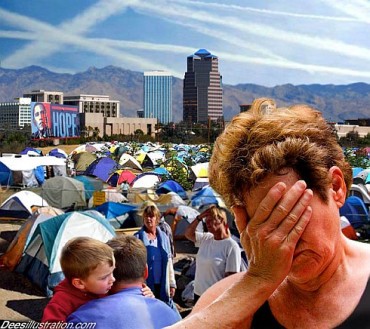The class lasted from 9am to 6pm with a 30 minute lunch break right there in the range. About 400 rounds were fired during the morning and in the afternoon we used airsoft Glock replicas and revolvers loaded with wax projectiles (those DO hurt). There were twenty people in the class, over half of them police officers, mostly GEOF G.E.1 (Federal Special Operations Group, something like a Federal police SWAT) and the rest were non law enforcement, of which nearly all of us except maybe two or three were firearms instructors.
You could tell right away the general level was pretty good. People would draw and shoot with acceptable speed and accuracy, same for reloads. No one needed to be explained what a tactical or a fast reload was, or how to clear a malfunction. This of course makes for a faster paced class and you make much better use of the time you have.
The class started with a small introduction by instructor Jorge Baigorria. There was no shouting, no bravado. Almost whispering he mentioned several recent incidents, where the techniques about to be taught have saved lives. He also mentioned the recent murder of Hernan, how a fighter´s heart makes you keep fighting even when mortally wounded. During the class yes, you where shouted at, kicked and pushed so as to add some stress to certain situations. Credentials of the instructors where not needed, especially since the important credentials in this sort of thing are the ones you don’t brag about nor do you put them in any CV or bio. No one there, students or instructors need to prove anything. We were all there to learn and improve ourselves as gunfighters. Maybe what I noticed the most was the down to Earth level of the conversation, how urgent it felt to be ready to handle violence that was already there, already in our lives and all around us. Bad guys don’t just rob, they kill you like a dog without remorse and given the current politics and lack of space in Argentine prisons they just walk. We weren’t training for some nut shooter in a mall or a terrorist, but the bastards already waiting right outside the club as we trained there, the ones waiting for you in the corner of your block. Several of the attendants have been involved in gunfights and had been wounded. What we were training for wasn’t something unlikely to happen. Quite the contrary, it was something that had already saved lives of those attending and could save any of us again in the future.
We started drawing and shooting (carrying concealed) 12, 3, 6 and 9 o’clock. Then we shot while moving diagonally back and forth. When you ran out of ammo you just reloaded and placed another 2 shots on target for good measure. We practiced the more typical close range drills, then from “surrendered “ positions on your knees or face down on the floor. Another interesting exercise was running from a barrel to another and finding a gun in a box that could be in condition one, two, or three. You had to grab everything inside the box, your gun and one or two extra mags, maybe a folder as well and a flashlight, then run back to the first barrel and engage the enemy as best as you could, using cover, shooting a couple rounds then going back behind cover and shooting from the other side, standing or from the ground, that was left to your criteria.
After lunch we used the air soft and wax ammo revolvers. We started with “suicides”, 1 vs 1 without moving, then moving, then 2 vs 1. After that we ran several real life scenarios, home invasions with a hostage family member, robbery at the bank, while buying a car, all cases that actually happened and using the transcript of the actual case.
Lessons learned:
*Check your gear before going to the range. One police officer had this awful cheap soft IWB holster that collapsed without the gun. Its just impossible to keep up when its so hard to reholster.
*If you can, wear body armor. Defensive shooting training is a high risk activity, make that advanced defensive shooting in all directions, while moving, with people left and right and it becomes a very high risk activity. Can you trust others with your life? Sometimes you have, but why risk it during training when you can wear armor?
* I used a fullsize Glock .40, Wolf ammo, not a single malfunction.
*Don’t waste your time and money and invest in a good pistol with quality ammo for these classes and for your defense. If its reloads, make sure they are good. Its not just about your time, if you experience problems with it you’ll waste other people’s time as well.
*Water, extra ammo just in case, multitool, bug repellent, all that should be in your bag. A shemagh around your neck helps keep hot empties from going into your collar and down your shirt.
*During force on force on force we saw how common it was to get hit in the hands and arms. Almost 50% of us got shot in the arms when using the air softs. Why? Because when you shoot your arms are naturally located in the center of your chest. When shooting single handed you still bring your left arm up to the chest. I got shot in my left arm doing just that. A shot there beats a direct hit in the chest! Practice “Making yourself small”, bring that other arm up when shooting single handed, covering your heart, cant the torso making yourself a smaller target.
*Since the odds of getting shot in the arms/hands is so high either because of natural defensive stances or because you’re shooting, its very important to be proficient with your other hand, know how to draw, shoot and reload with your non dominant hand.
*Just two guys got shot in the face. I’d say chances are 10% or less when the target isn’t just paper, but a live, moving and fighting person. This also means that body armor increases your chances of survival a lot. During high risk situations, BA is clearly worth it.
*According to those that got shot in gunfights, they either felt nothing at all and only later realized they had been shot, or barely felt a sting or burn where shot. The bad guys didn’t fly through the sky when hit, they simply collapsed in place, forward or backward as if losing wind, making guttural sounds.
*Reloading, tap-rack-bang, drawing fluidly, you have to practice all these to become proficient. It’s a perishable skill.
*People do miss even when shooting at very close range, a guy dropped his gun during struggling. Things that happen that you don’t see when just punching paper.
*One of the things that became obvious was that 6 shots is just too little when facing more than one attacker.
*When surprised and caught off guard, we could see that its best to wait for the opportunity, a moment of distraction to shoot, grab the gun of your attacker, etc. Action beats reaction, but act with a plan anticipating your next move when there’s more than one attacker.
*In many of the cases, you realized you often don’t know who the bad guys are. Yes the one with the gun pointed at you is clearly a bad guy, but what about the half a dozen people around you? Clients, innocent victims? Or accomplices that will shoot you in the back?
 Join the forum discussion on this post
FerFAL
Join the forum discussion on this post
FerFAL
 Join the forum discussion on this post
Join the forum discussion on this post












 The way of using it is pretty straight forward. Clean up the wound with soap and water, dry so that there’s no moist the apply sugar directly into the wound. In some cases its recommended to first apply honey and then sugar so that it sticks. The people I know, they used sugar simply powered directly into the wound. The sugar crystals should go inside the wound when possible. After that, cover the wound with sterile dressing.
The way of using it is pretty straight forward. Clean up the wound with soap and water, dry so that there’s no moist the apply sugar directly into the wound. In some cases its recommended to first apply honey and then sugar so that it sticks. The people I know, they used sugar simply powered directly into the wound. The sugar crystals should go inside the wound when possible. After that, cover the wound with sterile dressing.












